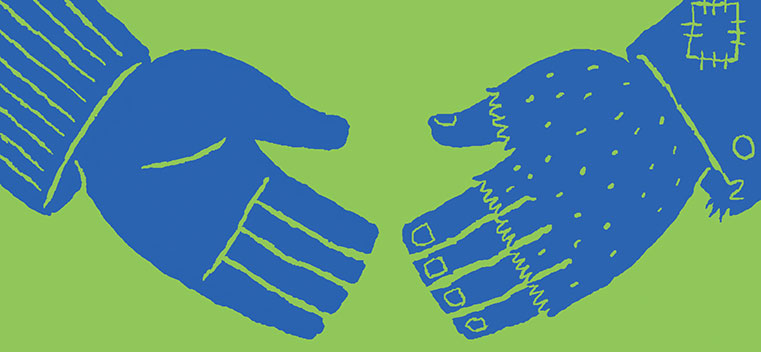
A Helping Hand
Tell us what you think. E-mail comments or questions to the editors at letters@northwestern.edu.
Ever wonder about those strange designations we use throughout Northwestern to identify alumni of the various schools of the University? See the complete list.
Find Us on Social Media
Medical students reach out to their neighbors in need.
On a warm September afternoon in Chicago, Justin Park and Elizabeth Fang approach William, a middle-aged man with a neat handmade sign that reads “Homeless ’N’ Hungry.”
William smiles when he sees Park’s familiar turquoise vest, the uniform for Feinberg School of Medicine students who volunteer with Good Neighbors. The outreach program, a partnership between the medical school and the Chicago Lights Elam Davies Social Service Center, helps the homeless in Streeterville, the downtown neighborhood that is home to Feinberg.
Fang, a second-year medical student, tells William, a regular, that she’s surprised to see him here, at the corner of Chestnut and Rush, and not in his usual spot on Michigan Avenue. Park gives William snacks, a toothbrush, razors and deodorant, and bottled water.
On this day, Park and Fang talk with eight men, all along Michigan Avenue or within a stone’s throw of the Magnificent Mile. They encourage Bob, a Vietnam War vet who is treating an unexplained rash on his head with lighter fluid, to visit the emergency room. They give snacks to Q, a 16-year-old South Sider who was recently shot twice in the leg while playing basketball. He has a place to sleep but nothing to eat.
Fang, a second-year Good Neighbors volunteer who grew up in Washington, D.C., attended Washington University in St. Louis and spent a summer in New York City, says homelessness is more visible in Chicago than in any other place she’s lived. At first she offered money to the homeless men and women she passed on the street. “But, you know, I’m a student. I don’t make much money,” she says. “I thought there must be a better way.”
That’s when she got involved with Good Neighbors.
Good Neighbors “is really about respecting people’s dignity and worth. We focus on learning people’s stories and hope that, eventually, they will come into the center and we can help them make some changes.” — Dan Hula
On Friday afternoons the three- to four-person Good Neighbors teams, made up of Feinberg students and staff and interns from the Fourth Presbyterian Church–based EDSSC, venture out into the neighborhood, carrying a duffle bag of snacks, toiletries and clothing. Trained in motivational interviewing, the volunteers listen for problems and offer possible solutions.
The outreach began when a group of medical school students started handing out homemade meals to people experiencing homelessness in Streeterville. “It started with students who were grappling with their own discomfort,” says former Feinberg Office of Diversity director Sunny Nakae.
When the students approached Nakae about the challenges of providing consistent service, she encouraged them to seek a partner in the community. The students reached out to EDSSC director Dan Hula, and together they created a sustainable street outreach program to build rapport and trust with people living on the streets.
Since Good Neighbors launched in April 2013, volunteers have made contact with nearly 80 homeless men and women and handed out more than 2,000 supply items.
More than one-time, short-term assistance, the outreach is a gateway to connect people with the EDSSC, where they can meet with a case manager and get help with housing, employment and legal services. They can also take a shower, pick out clean clothes and get fresh food items.
Good Neighbors “is really about respecting people’s dignity and worth,” Hula says. “We focus on learning people’s stories and hope that, eventually, they will come into the center and we can help them make some changes.”
The outreach experience was eye opening for Rochester, N.Y., native Justin Park. “This is my first time in a big city, my first time seeing homeless people,” he says. “It’s an issue that I don’t want to run away from or ignore.”
The first-year medical student says Good Neighbors will help him become a better clinician by building “the mindset and communication skills to help people in the community from all different socioeconomic backgrounds.”
The outreach volunteers learn firsthand about some of the social determinants of health, says Nakae. “For example, if you prescribe a medication that has to be taken regularly with meals — what if a person doesn’t have consistent access to food?”
The students also experience what Nakae calls instructive discomfort. “Learning how to manage your own reactions and stay focused on caring despite distractions makes you a stronger clinician,” says Nakae, who recently started an appointment at Loyola University Chicago. “Through real interactions, Good Neighbors ultimately challenges students to be more introspective and helps them continue to develop empathy and communication skills.”



 Facebook
Facebook Twitter
Twitter Email
Email


